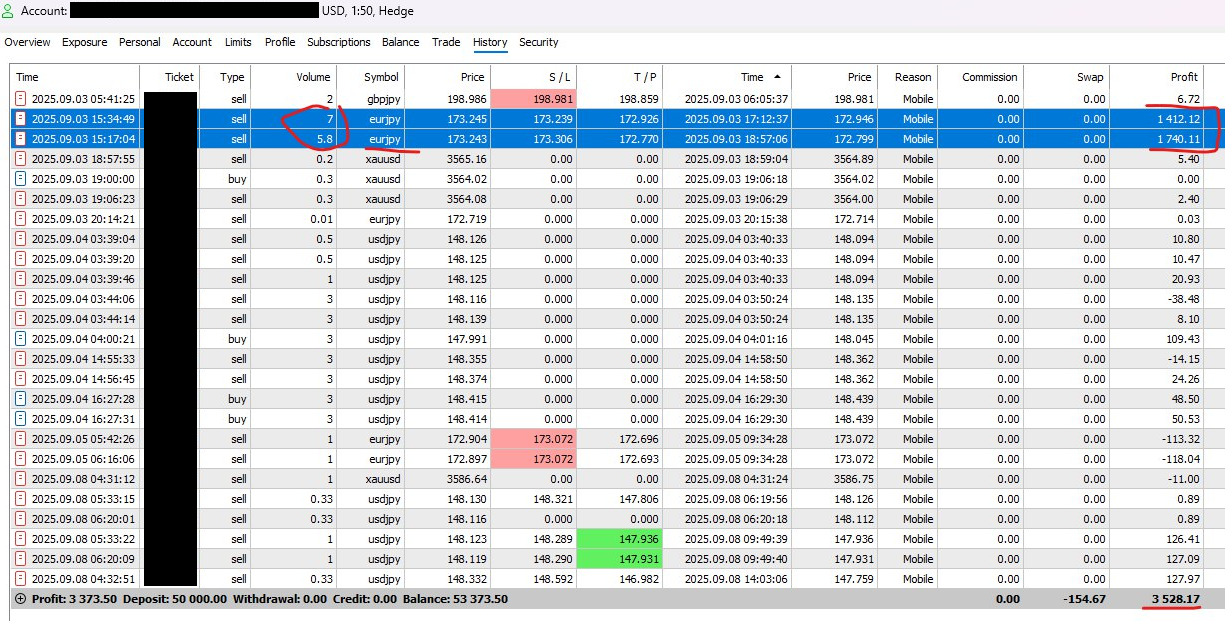Funded7 is designed to evaluate and partner with traders who demonstrate consistent, disciplined, and repeatable trading skills. (For details, please see our FAQ: “The Funded7 Ideal Partner“).
Our programs are not designed to reward one-off gambles or high-risk strategies that rely on luck. To ensure fairness and maintain the integrity of our program, we review accounts for trading patterns that are deemed to fail to demonstrate consistency.
This article explains what “failing to demonstrate consistency” means, how we measure it, and provides clear examples.
What Does “Failing to Demonstrate Consistency” Mean? #
A trading pattern that “fails to demonstrate consistency” refers to an approach where an account’s success is dependent on a “single trade idea” (which can be a single trade or a cluster of highly similar trades) rather than on stable, diversified trading performance over time. It is an approach that fails to prove “consistency” as a skill.
This is not an issue with the lot size itself. The issue is “how the profit was generated”—whether the profit demonstrates a sustainable skill (where consistency can be confirmed) or if it shows a dependency on a single high-risk event (where consistency cannot be confirmed).
Real-World Examples of Trading That Fails to Demonstrate Consistency #
Below are actual, anonymized cases that were flagged for review.
Case 1: A Single Cluster Accounts for the Majority (Over 85%) of Profit #
- Profit Concentration: The majority of the account’s profit was generated from a single trading cluster consisting of five consecutive USDJPY Buy trades executed within less than one minute on October 15, 2025, all at the same entry price of 151.476. Each trade closed within seconds of one another at nearly identical prices (151.624 – 151.639), producing a total combined profit of approximately ¥2,060. This cluster alone represents over 85% of the account’s total profit, while subsequent smaller trades either yielded minimal gains or small losses.
- Profit Impact: Outside this cluster, the remaining trades (0.6-lot USDJPY positions later in the day) produced net losses totaling around ¥-550, confirming that the account’s profitability depended solely on this single sequence of concentrated trades.
- Verdict: This account’s profit was entirely derived from a single high-risk trading event, executed through repeated entries on the same instrument and price level within seconds.
Case 2: A Single Cluster Accounting for the Majority (≈89.3%) of Profit #
- Profit Concentration: Two consecutive EURJPY Sell trades generated a combined profit of $3,152.23 ($1,412.12 + $1,740.11).
- Profit Impact: Given the total account profit of $3,528.17, these two trades alone account for approximately 89.3% of all profit. This shows that nearly the entire performance was achieved through a single exposure cluster.
- Verdict: This is another clear example of trading that fails to demonstrate consistency, as the vast majority of the total profit was earned using disproportionately large lot sizes compared to other trades.
Regarding Reviews for “Consistency” and Payout Growth Support #
Funded7 may review your trading activity. If, as a result, it is determined that specific trading patterns raise concerns from the perspective of “Consistency” as outlined in our philosophy (see FAQ: “The Funded7 Partner Profile” for details), we will explain our thought process and the steps involved.
Our goal is to support disciplined traders in achieving sustainable success. However, to protect the integrity of our platform, we cannot tolerate actions that intentionally treat prop firms like a casino through gambling-style trades, especially when the trader is aware that such actions may eventually lead to disqualification or platform bans.
The Process When Consistency Concerns Arise:
If consistency concerns arise during your payout request review, the approval for that specific payout will be temporarily put on hold. However, this does not mean disqualification or the permanent forfeiture of your profits.
We want to believe that significant profits are based on your solid skills, not just luck. Therefore, we treat the eligibility of this highlighted profit as “temporarily pending” and offer you an opportunity to prove your skill.
How to Prove Skill and Enable Payout for Pending Profits:
You will be asked to continue trading in the normal market environment. As “proof” that your underlying skill is genuine and sustainable, we may ask you to achieve specific targets within a set period (e.g., achieve ¥XXX profit over XX trading days with risk per trade below X%, tailored to your situation).
This is not a penalty, but a validation process to confirm that your skills are truly sustainable. Once this “consistent trading skill” is clearly demonstrated in your subsequent trading, the initially pending profit will also be deemed validated by your skill and will be approved as eligible for payout.
We want to evaluate and reward “genuine skill” as a long-term partner, not just short-term results. At the same time, please understand there is a clear line regarding undisciplined actions.

